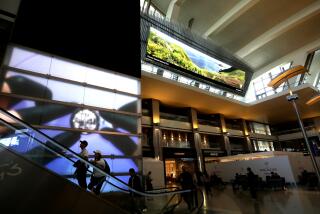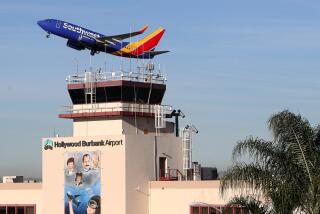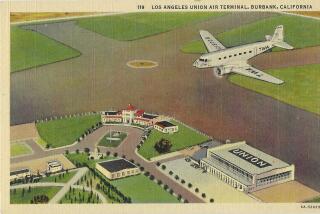Crowded Skies Over Japan
- Share via
TOKYO — The spanking new $3-billion Kobe air port has been open for just two months, but there are already lines to use it.
Lines of planes waiting to take off and land.
In the first weeks of operation, air traffic controllers have been forced to order an unusually high number of incoming flights to circle the airport so planes on the ground can get safely in the air. The new airport in Kobe is the third major airport within a 25-mile radius.
The crowded skies over Osaka Bay are a symptom of a wider problem of scattered airports that is turning Japan, once the biggest hub in Asia, into a destination international air travelers increasingly seek to avoid. In a country with so many airports competing with one another, critics ask, just how many airports can Japan sustain?
Japan now has 97 airports. And counting. Throughout the last decade of dismal economic growth, municipalities and prefectures continued to cut ribbons on new airports at a breathless pace.
Many were planned during the bubble economy of the late 1980s, when the sky was no limit, fueled by passenger projections that turned out to be wildly unrealistic when Japan’s economy stalled. Many of those airports struggle to break even.
The proliferation of airports has not resulted in lower prices for consumers here. In a country of 126 million highly mobile people, transportation remains expensive -- whether by plane, train or automobile. And unlike Europe, where discount airlines have made it cheap to fly about the continent, Japan has no discount airline to undercut the two main carriers, Japan Airlines and All Nippon Airways.
Japan’s problem, a legion of analysts say, is that airports have been built to satisfy the desire of local politicians to showcase an airport in their own backyard, without much thought given to integrating Japan’s highly efficient rail system with its network of international and domestic flights. They describe it as a perfect illustration of Japan’s addiction to massive public works projects.
The result is that Japan’s airline industry is struggling in the midst of an Asian boom.
“Local politics is hijacking good sense,” says Anthony Concil, spokesman for the International Air Transport Assn. Concil came to his job with 17 years of experience in the Japanese airline industry and says Japan’s foremost need is to increase capacity and improve access to Narita Airport, the 22-year-old international airport that struggles to serve the massive Tokyo metropolitan area of nearly 30 million people.
Derided by travelers as too hard to get to and by airlines for having the most expensive landing fees in the world, Narita has seen itself surpassed as an Asian gateway in recent years by state-of-the-art airports in Singapore and Hong Kong.
Once Asia’s busiest gateway for international travelers, Narita has fallen to fourth, with Seoul just behind and growing almost four times as fast, according to the Airports International Council.
“Narita hasn’t kept up; there’s a lid on traffic into the airport,” Concil says. “They still have a capacity problem at Narita, and building more airports in the countryside isn’t going to solve that.”
But the money keeps being funneled to regional airports. Nagoya, a major city sandwiched between well-served Tokyo and Osaka, got its own international airport last year. And the month-old Kobe airport is no longer even the country’s newest since another opened in March in Kitakyushu, replacing that city’s existing landlocked airport.
Yet another is under construction at Shizuoka, slated for opening in March 2009.
The Japanese government has vowed that Shizuoka’s new airport will be the last to be built in small cities -- for a while, at least -- with Prime Minister Junichiro Koizumi putting the brakes on airport construction as part of its program to curb wasteful public spending. But many here suspect that politicians will not be able to wean themselves from the vast amounts of public money that have traditionally been available for big construction projects.
They note that the Kansai International Airport in Osaka is pressing ahead with the construction of a second runway and terminal, and that the southern metropolis Fukuoka, a hop from the booming markets of Shanghai and Seoul, may still succeed in the push to build itself a new facility.
“These public works continue because of a cozy relationship between the political arena, bureaucrats and the business world -- and the business world here means the construction business, not the airline business,” says Takayoshi Igarashi, a professor at Hosei University. “Those local airports produce red ink. But no one takes responsibility.”
The Osaka region’s clashing runways are a prime example. The area is already served by Kansai, with its 100,000 domestic and international takeoffs and landings a year. Built 10 years ago, Kansai was supposed to replace the dowdy prewar Itami airport -- officially known as Osaka International -- which is just 10 miles from downtown Osaka but was constantly battling noise complaints from residents.
But Itami survives, even thrives. It turned out that many domestic passengers didn’t like the long trip to Kansai, an airport built on landfill and slowly sinking, in the middle of the bay. Itami cut the time to get to downtown Osaka and was also closer to the historic old capitals of Kyoto and Nara so loved by tourists.
So Itami was renovated and its number of daily domestic flights is rising. Meanwhile, Kansai’s domestic business is declining.
Now, Kobe has been added to the mix, further cannibalizing domestic traffic. And whereas the runways of Kansai and Itami were at least roughly parallel, allowing planes to take off simultaneously, Kobe’s runway cuts across those flight paths, affecting the efficiency of all three airports.
To local politicians in the Kansai region, having three major airports is appropriate for a rich economic zone of about 24 million people, with its heavy volume of business travel and the allure to tourists of nearby Kyoto.
“The three airports in the Kansai area have different functions,” says Satoshi Uotani, assistant director of the planning section of the Civil Aviation Bureau. He defended the decision to build the Kobe airport and insisted that there was a need for another runway at Kansai International.
The airports’ defenders also point out that the recently privatized Narita, after years of criticism that its landing fees were too high, finally cut the duty it slaps on airlines by 20% -- though other tax increases ate away at some of that savings. And the regional airports contend they can turn a profit using discount offers to steal customers from the trains and make flying a habit.
The operators of Kobe airport are banking on being able to get passengers from Kobe to Tokyo faster and cheaper than is possible on Japan’s swift but expensive bullet trains. And at Nagoya’s new airport, the things you can do while waiting to catch a flight include getting married at the airport’s chapel.
But critics counter that what Japan needs is not competition between planes and trains, but closer integration that would take passengers to hubs that then move them efficiently to smaller centers.
“This a country that is so advanced with the bullet trains, yet no one seems to have the idea of tying the two systems together,” Concil says.
“Things won’t get better until they stop building to serve local communities, and build a proper network.”
*
Naoko Nishiwaki of The Times’ Tokyo Bureau contributed to this report.
More to Read
Sign up for Essential California
The most important California stories and recommendations in your inbox every morning.
You may occasionally receive promotional content from the Los Angeles Times.










